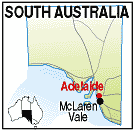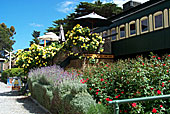|
Soon after the first European landed at Glenelg in 1836, they discovered the
fertile land to the south. By 1838 the Onkaparinga River had been forded and
the land where McLaren Vale now stands had been surveyed, with the first settlers
taking up holdings. Two small villages. Bellevue and Gloucester emerged at the
southern and northern ends of the present township.
The land was cleared for cropping and combined with an expertise in animal husbandry, the region flourished. By 1850, grain growing was the predominant industry and sheep and cattle grazed the land. The soil soon began to lose is nutrients and erosion became a problem. Many of the smaller farms became economically non-viable and, when the government opened up new areas in other regions, the population declined and the district began to lose its impetus. The farmers who remained formed self help groups, encouraged innovative methods, and held field days to spread their news of success amongst themselves. Grapes, which had first been planted in 1838, became more prominent, largely due to the efforts of Thomas Hardy. Others followed Hardy's lead and a promising new industry emerged. By the 1880's wealthy businessmen from Adelaide were investing in the industry and wealth was restored to the area. The wine-makers fortunes varied during the decades which followed.Much of their produce was sold to Britain, and changes in their policies, two World Wars, the Great Depression, and changes in consumer tastes affected the industry. Today there are around 90 wineries in the district. Two thirds of them are less than 25 years old. Notably they produce high quality reds, and some whites, for both domestic and international markets. Tourism has also become a by-product of the wine industry. Most wineries are open 7 days for tastings and cellar door sales,and quality accommodation and restaurants provide for the many visitors to the region each year. There are a number of excellent plant nurseries in, and around the township, offering a large range of traditional and more unusual plants. Local art and craft are featured in galleries, in some of the wineries, and in restaurants. McLaren Vale is an ideal place to stay for a tour of the Fleurieu Peninsula. Those who have not yet experienced the pleasure of a visit to the Southern Vales have much to look forward to in this scenic and interesting part of South Australia. PLACES OF INTEREST: SEE WINERIES MAP GRAPE VARIETIES AROUND McLAREN VALE Cabernet Sauvignon Cabernet Sauvignon was first planted in 1838 and remains the foremost red variety grown in the southern Vales. The grape gives great depth and body to wines and consistently provides some of the finest red wines of the area. The variety ripens early and is picked in early March. Chardonnay Chardonnay has become very popular in recent years and plantings are becoming much more extensive. Grenache Grenache is a high bearing vine which is used for bulk, red table wines, tawny port and brandy, and is often blended with other grape varieties. Merlot and Pinot Noir These varieties have been introduced in the past 20 years and are used in the production of red, table wines. Rhine Riesling Rhine Riesling has become the most important of the white grapes of the Southern Vales and both sweet and dry table wines are made from the grape. Sauvignon Blanc Sauvignon Blanc is grown to produce very distinctive, fortified white wines, and for the production of high quality, dry table wines. Shiraz Also sometimes known as Hermitage. it is a very hardy variety of grape and is used to produce quality red wines and the vintage ports for which the McLaren Vale region is renowned.
SOME IMPORTANT DATES ABOUT McLAREN VALE
|


© Copyright Peter W. Wilkins




